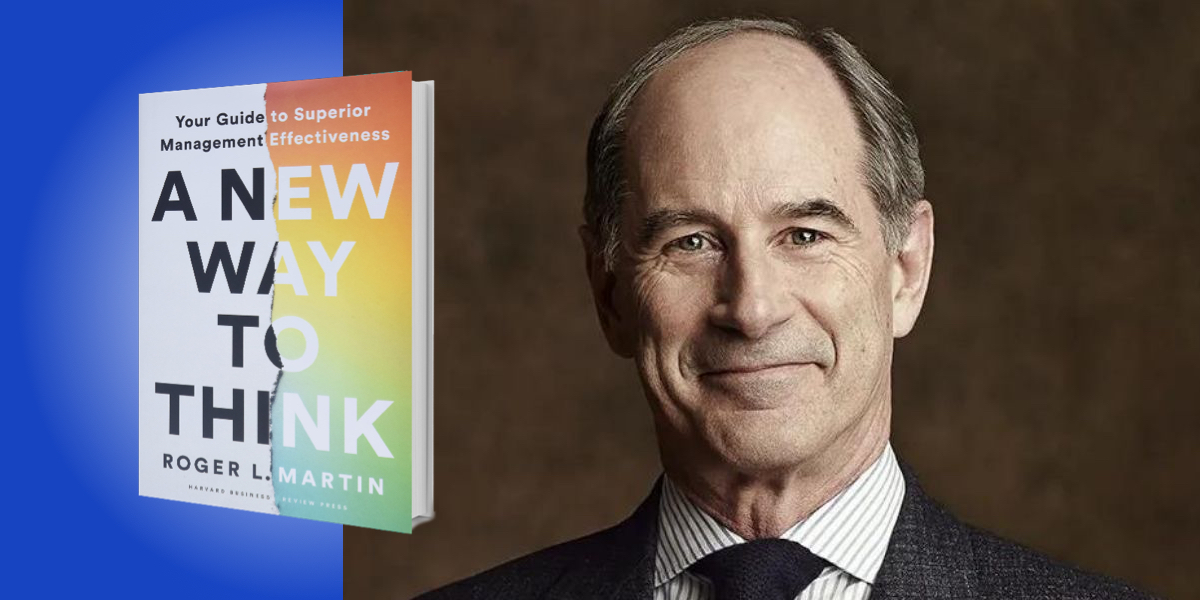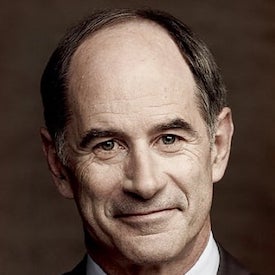Roger Martin is a business book author of bestsellers including The Opposable Mind, The Design of Business and Playing to Win. He advises CEOs and was formerly Dean of the Rotman School of Management at the University of Toronto.
Below, Roger shares 5 key insights from his new book, A New Way to Think: Your Guide to Superior Management Effectiveness. Listen to the audio version—read by Roger himself—in the Next Big Idea App.

1. If you are not careful, your models can come to own you.
Humans are not random. We take actions based on the way we frame and understand our context. That is, we model our world in order to choose our actions—whether we know that we are using a model or not.
Some models tend to work. For example, be courteous to your waiter/waitress and you will probably get better service. But some models don’t. For example, when the person with whom I am engaged in discussion didn’t agree with me, my model used to be to explain my point of view more robustly. I didn’t recognize that it was my model; it just seemed like the right approach.
I didn’t appreciate that the more I applied my model, the more the disagreement was entrenched. But that didn’t stop me from applying my model. Until I met a wise man, the late Chris Argyris, who helped me understand that my model was deeply flawed, and a better model was to inquire into the other person’s point of view. His suggested model balances advocacy of my own point with inquiry into the other person’s.
Prior to Chris’ intervention, I was owned by my model. I was dedicated to it even though it lacked positive results. Once I owned my model, I used it consciously because it worked and thus deserved a place in my toolbox of models.
2. Assume that people in corporations are just like regular people.
In the realm of the corporation, there is an implicit assumption—a model—which holds that when a Homo sapiens enters a corporation, that person changes into another species: Homo corporaticus. Therefore, we should treat them in ways we wouldn’t treat Homo sapiens outside the realm of a corporation. That is a bad model.
“Humans don’t suddenly change when they cross the boundary into a corporation.”
Our model of Homo corporaticus holds that if we want to attract, motivate, and retain high-end talent, then our most important tool is compensation. If another corporation can pay them more, then we will lose them. But is that how regular people outside of a corporation behave? Are they motivated first and foremost by maximal monetary compensation for whatever activity they engage in? Do you choose your activities on the basis of monetary compensation? Is that why you serve on non-profit boards or volunteer at the soup kitchen? Of course not. You choose to spend time on activities where:
- You are appreciated for being your own unique self.
- Your thoughts and ideas are not dismissed.
- Your personal growth is supported, not blocked.
- Your work is noticed and begets pats on the back for jobs well done.
For regular Homo sapiens, those things are more important than the marginal dollar—and humans don’t suddenly change when they cross the boundary into a corporation.
Similarly, Homo sapiens generally don’t respond well to “do as I say, not as I do”—as smoking parents find when they tell their kids not to smoke. It doesn’t work in corporations either. A CEO can declare that they want a culture change, like to be more entrepreneurial and less bureaucratic. It is guaranteed that nothing will change unless that CEO acts in a more entrepreneurial and less bureaucratic way in their own dealings. In the real world, followers are motivated to do as their leaders do.
3. Data analytics are the enemy of change.
For the past half-century, business education has taught that the only good business decision is one made on the basis of rigorous, data-based analysis. Anything else is unbecoming to a business manager. So, we were all taught how to collect samples, crunch the numbers, and test for statistical significance.
“The only thing data analytics will do is convince you that the future will be identical to the past, or continue the precise trend of the past indefinitely into the future.”
As part of that, we learned the importance of collecting a representative sample. The sample must be randomly selected from a pool that is representative of the universe about which we seek a statistical inference. Meaning, if we want to know what color customers in general prefer, we better not only sample males, or just elderly people.
But we weren’t taught that since 100 percent of the world’s data is from the past, the implicit assumption we are making whenever we take a sample and draw statistical inference is that the future will be identical to the past. Otherwise, the sample will be unrepresentative and unusable.
The only thing data analytics will do is convince you that the future will be identical to the past, or continue the precise trend of the past indefinitely into the future. As such, data analytics is the enemy of change. To create a future that is distinct from the past, you have to heed Aristotle’s warning (as the father of data analytics) and recognize that you have to imagine possibilities and choose the one for which the most compelling argument can be made—and, importantly, Aristotle argued against using data analytics for this.
4. Office towers are factories that manufacture decisions.
The biggest change in the structure of companies over the past century is that, a century ago, the vast majority of employees were in factories, and now the majority of employees and super-majority of the wage bill are in office towers or parks. If we ask what those people do, it is clear that they don’t produce products or services. What they manufacture is decisions.
They decide what to produce, where to produce it, where to sell it, how to price it, etc. They are in Decision Factories. The implicit assumption behind the Decision Factory is that it operates like the actual factories that used to dominate business.
“Within 25 years, all large companies will define jobs around projects.”
Those factories had flat jobs: come in for your shift on Monday and do pretty much the same thing all day, then repeat that for the rest of the week, month, and year. The work in Decision Factories is completely different. The need for a particular decision becomes evident, is worked on, resulting in a decision, and then it goes away, often never to be seen again—for example, the decision on how to launch a given new product. In a Decision Factory, work is organized around projects—projects that are related to decisions that come and go.
Despite this, we have defined jobs at Decision Factories as flat jobs, as if they are in a manufacturing facility. This makes Decision Factories grotesquely inefficient. Productivity increases are minimal in the Decision Factories of our economy, while manufacturing and service operation productivity increases strongly every year. This will only be fixed when companies define jobs around projects.
This may seem farfetched, but it is how $50 billion companies like Deloitte and Accenture organize themselves, as well as movie studios. Within 25 years, all large companies will define jobs around projects. Get to the front of that line instead of waiting at the back.
5. Corporate management’s primary job is not coordinating the lower levels, but rather assisting them in competing.
The general view is that great companies in an industry compete against one another: Coca Cola against PepsiCo, Amazon vs. Google vs. Microsoft, or GM vs. Toyota vs. VW. But they really don’t—at least not from the perspective of customers.
When customers want bottled water, they don’t say, “Shall I buy Coca Cola or PepsiCo?” They say, “Should I buy Dasani or Aquafina?” Or when they want a sports drink, it’s Powerade or Gatorade—not Coke or Pepsi. The competition for the customer is Dasani vs Aquafina, Powerade vs Gatorade, etc.
The only utility that Coca Cola or PepsiCo has is helping Dasani or Powerade win. Coca Cola can control and coordinate to its heart’s content, but that won’t help Dasani or Powerade. To be useful, the corporation has to think about how it can help competitively—like cheaper distribution costs or scale advantage in advertising. The flow needs to be reversed from fully top down to a healthy dose of bottom up.
To listen to the audio version read by author Roger Martin, download the Next Big Idea App today:
































